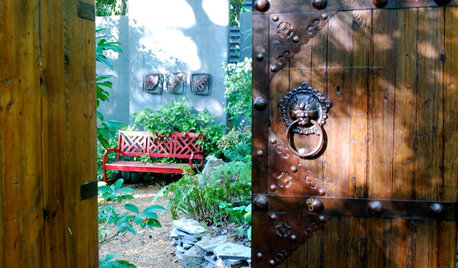It's gotten personal!
LuvMyRazz
10 years ago
Related Stories

HOUZZ TOURSMy Houzz: Creative DIY Personalizes a 2-Bedroom Bungalow
Stenciling, custom finishes and furniture, and Scottish-inspired style give a 1920s home personality and warmth
Full Story
KITCHEN DESIGNPersonal Style: 50 Clever Real-Life Kitchen Design Details
Get ideas from savvy homeowners who have a knack for creating kitchens celebrating personal style
Full Story
HOLIDAYSHouzz Call: Share Your Personal Holiday Traditions
What winter rituals mean the most to you and yours? Post your stories and pictures
Full Story
HOLIDAYSGift Wrap Ideas That Add a Personal Touch
Give more meaning to your gift giving with these simple but creative designs
Full Story
ECLECTIC HOMESHouzz Tour: Personal and Plaid
When it comes to interior design, Scot Meacham Wood wears his heart on his tartan sash
Full Story
LANDSCAPE DESIGNExplore Your Garden Personality: The Collector
Abundant in plants, art or even oddball items? These principles can help you make sense of them in the landscape
Full Story
LIGHTINGPersonal Spaces: Homeowners Work Their Pendant Lights
See how all kinds of rooms are getting a lift from hanging lights, both budget-friendly and glam
Full Story
DECORATING GUIDESStretch Your Design Possibilities With Polyester
You know it from psychedelic stretch pants (er, maybe not personally). But did you know it's now in rugs, coatings and glass substitutes?
Full Story
BEDROOMS5 Tips to Wake Up Faster and More Happily
Shine when you rise even if you're not a morning person with these strategies to banish the brain fuzz
Full Story
KITCHEN DESIGNHow to Find the Right Range for Your Kitchen
Range style is mostly a matter of personal taste. This full course of possibilities can help you find the right appliance to match yours
Full StorySponsored







alabamanicole
LuvMyRazzOriginal Author
Related Professionals
Edmond Landscape Architects & Landscape Designers · Maple Heights Landscape Architects & Landscape Designers · Norwood Landscape Contractors · Broadlands Landscape Contractors · Danvers Landscape Contractors · El Reno Landscape Contractors · Fishers Landscape Contractors · Fountain Valley Landscape Contractors · Metairie Landscape Contractors · New Brighton Landscape Contractors · Suisun City Landscape Contractors · Jericho Stone, Pavers & Concrete · Agoura Siding & Exteriors · Honolulu Siding & Exteriors · Rochester Siding & Exteriorsourhighlandhome
alabamanicole
Tiffany, purpleinopp Z8b Opp, AL
LuvMyRazzOriginal Author
LuvMyRazzOriginal Author
jcalhoun
topsiebeezelbub
Tiffany, purpleinopp Z8b Opp, AL
daybydaybyday